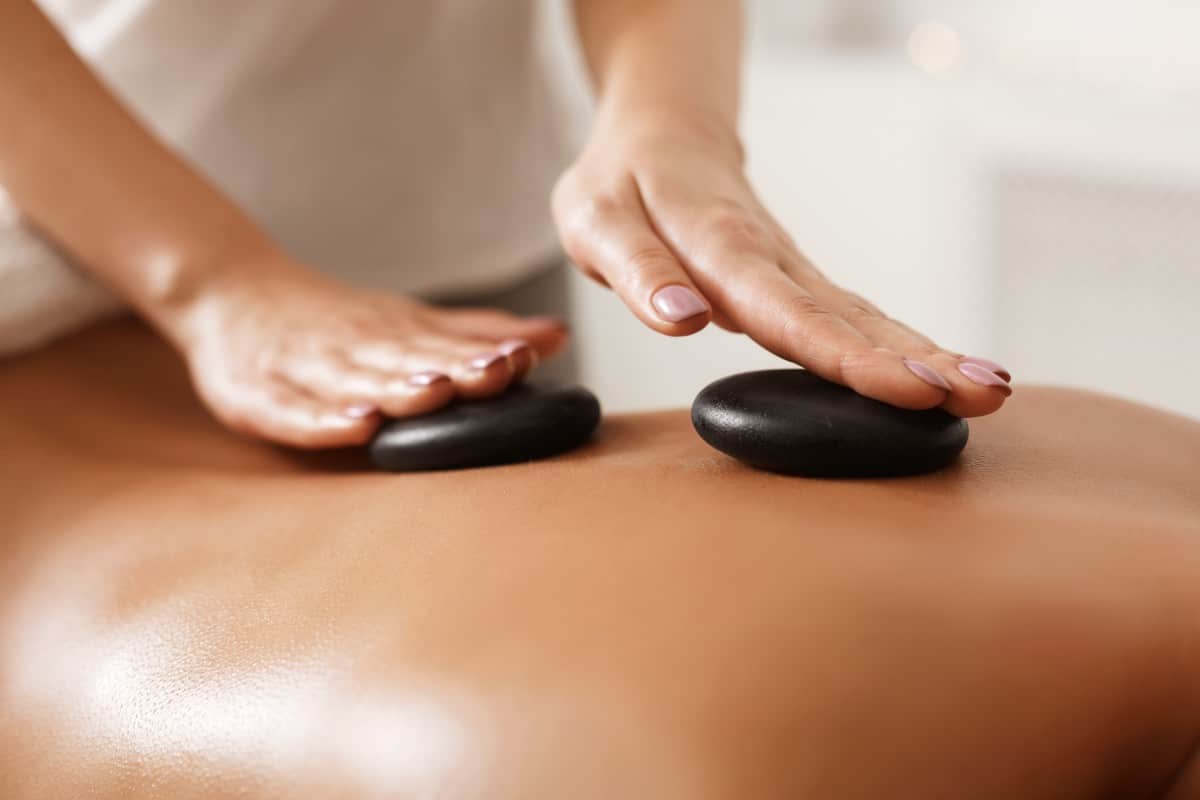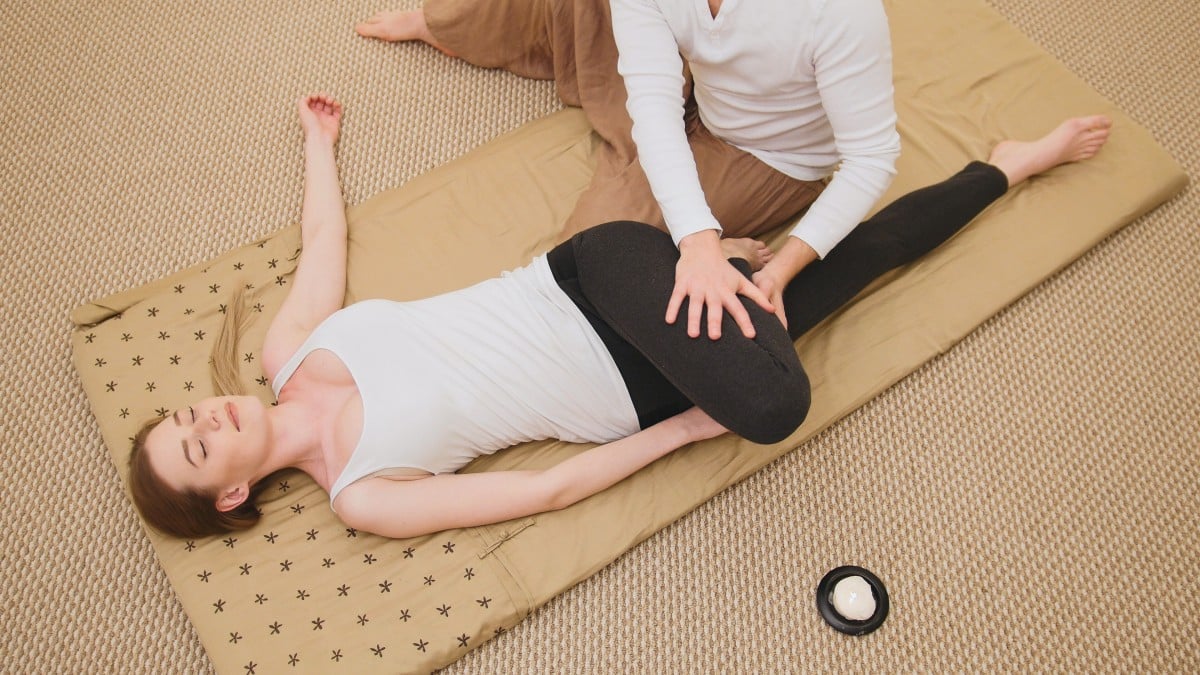The purpose of medical massage therapy is to treat and assist the healing process in acute and chronic pain related to connective tissue disorders. Incorporating medical massage therapy services into your holistic practice can provide significant relief to your community while boosting your overall revenue cycle. Keep reading to learn more!
What Is Massage Therapy?
A type of integrative medicine, massage therapy involves a certified massage therapist who manipulates the soft tissues of the body, including muscle, connective tissue, tendons, ligaments, and skin. By using varying degrees of pressure and movement, the massage therapist can induce pain relief for health conditions or relaxation for overall well-being.
Massage therapy offers numerous benefits for people seeking treatments for relaxation and health issues. According to the American Massage Therapy Association, some of the benefits of massage therapy include alleviating:
- Anxiety
- Depression
- Low immune function
- High blood pressure
- Heart rate issues
- Chronic pain
- Limited range of motion
- Poor quality of sleep
There is also limited evidence that massage therapy can help improve various health conditions including, but not limited to dementia, carpal tunnel syndrome, chronic headaches, post-surgical and burn recovery, fibromyalgia, and reducing the effects of chemotherapy and nausea.
Medical Massage vs. Therapeutic Massage
There are a few ways that a medical massage differs from therapeutic—or “spa”—massages. One key difference is the technique used. Medical massage therapy incorporates many of the same techniques as therapeutic massage, but with more advanced modalities. In a spa massage setting, you might receive a general Swedish massage technique versus a more intense, localized technique in a clinical setting.
Another difference is the overall purpose of each type of massage. General discomfort in an area usually responds well to a therapeutic session, whereas the goal of utilizing medical techniques is to produce permanent changes or to maintain the health of the body’s tissue. For example, long-distance runners might implement medical massage into their holistic wellbeing plan to maintain their muscular strength and prevent injury.
Since medical massages happen in a clinical setting compared to a franchise spa practice, the medical massage therapist will have a more specific, targeted treatment plan for your visits versus making an appointment for relaxation at a spa whenever you want to.
3 Benefits of Adding Medical Massage Services to Your Practice
Incorporating medical massage services to your holistic practice can provide a handful of benefits, including:
Reducing Massage Therapy Burnout
A medical massage practice provides a daily, hour to hour, diversity of conditions and patients treated. Since there are so many types of massage therapy techniques and solutions, this diversity helps to prevent therapist burnout. By adjusting their methods for each patient, the medical massage therapist can stay nimble and not get ergonomically stiff.
Boosting Your Revenue Cycle
By offering another aspect of holistic wellbeing to your practice, you demonstrate a commitment to serving the overall wellness of your community. Adding an additional element of holistic healthcare means you can attract patients who are looking to find a massage therapist in their area and find your practice.
Operating In More Facets of Your Community
Due to the fact that massage therapists can treat a wide variety of ailments and conditions, your holistic practice can gain a bigger presence in your community. Some examples of where you can plug the massage therapist feature of your holistic practice—and thus gain referrals—include:
- Health clubs
- Health food stores
- Associations that services patient populations that you treat
- Medical clinics
- Dental clinics
- Psychology clinics
- Athletic events
- Health fairs
- Public bulletin boards
- Support groups
3 Considerations for Your Medical Massage Services
Medical Billing & Coding
When massage therapists deliver treatments, medical billing processes ensure that they receive reimbursements for their care. While medical billing is an integral function of the reimbursement process, it can be very complex; the slightest error can delay payments for weeks, if not longer. Ensuring the most accurate medical billing allows medical therapists more time to spend doing what they love: delivering care to their patients.
Hiring Massage Therapists
When hiring a massage therapist, let your patients know about it and post an announcement in your reception room. You’ll find that the word-of-mouth of your patients is a great referral source! There are massage schools in most major markets, plus you can post a job notice on the school bulletin board or in their newsletter.
Competing with Spa Massage Franchises
Wherever your holistic practice is based, there are probably a handful of massage franchises in your area that you’ll have to compete with when you include massage therapy as part of your services offered. Competition in any market is normal and to be expected; you can distinguish your practice from those chain operations by delivering quality services and educating your patients on the difference between so-called spa massages and medical massage therapy.
Turn to The Experts at HBS for Your Medical Massage Therapy Insurance Billing
While massage therapy has traditionally been a cash-based treatment in the United States, there is a growing trend toward practices accepting insurance. Expanding your business model by adding insurance billing for massage can increase your revenue while protecting your business from economic downturns.
Balancing your practice’s insurance enrollments, billing, and coding while delivering care to your patients can be overwhelming, but outsourcing your massage therapy insurance billing can save you time, energy, and streamline your revenue cycle management!
At Holistic Billing Services, we’ve helped thousands of practitioners and owners expand their practices by adding insurance billing for massage therapy. With an expert partner by your side, you can focus more on treating patients to help your practice grow rather than worrying about insurance billing. To learn more about our massage therapy billing services, talk to one of our billing and coding experts today.
Whether you suffer from physical or mental health issues, massage therapy offers an essential primary or complementary treatment option. Massage for wellness comes with many health benefits that help treat a variety of diseases and conditions. Read on to learn more about the different types of massages and how a holistic treatment plan can include massage therapy!
What is Massage Therapy?
A type of integrative medicine, massage therapy involves a certified massage therapist who manipulates the soft tissues of the body, including muscle, connective tissue, tendons, ligaments, and skin. By using varying degrees of pressure and movement, the massage therapist can induce pain relief for health conditions or relaxation for overall well-being. 
Massage therapy has its roots in both Eastern and Western medicine and has been practiced in most cultures to some extent. In fact, it’s one of the oldest remedies people have used for pain relief with a history that dates back about 5,000 years ago.
What are the Types of Massage Therapy?
There’s an array of different massage techniques, including:
Medical Massage
Unlike other forms of massage, which focus on relaxation, a medical massage is for medical needs and is prescribed by a physician as a form of treatment for diagnosed medical conditions. It’s also billed to insurance companies in fifteen-minute increments. The massage therapist may use a variety of techniques that will focus on the area of the body that is being affected by the medical diagnosis.
Swedish Massage
Swedish massage is a gentle full-body massage that helps to especially release muscle knots and fully relax patients.
Hot Stone Massage
 While this kind of massage therapy is similar to Swedish massage, hot stone massage involves heated stones instead of or in addition to the massage therapist’s hands. The heated stones help to improve blood circulation and relieve muscle tension for relaxation and pain relief. Generally, hot stone massage relieves more muscle tension than the Swedish method due to the heat involved.
While this kind of massage therapy is similar to Swedish massage, hot stone massage involves heated stones instead of or in addition to the massage therapist’s hands. The heated stones help to improve blood circulation and relieve muscle tension for relaxation and pain relief. Generally, hot stone massage relieves more muscle tension than the Swedish method due to the heat involved.
Aromatherapy Massage
This kind of massage therapy uses traditional massage techniques with the addition of essential oils. By combining gentle pressure with essential oils, this type of massage is designed for an emotional component. During treatment, the massage therapist will give a full-body massage while applying diluted essential oils to the skin.
Sports Massage
A sports massage is useful for treating repetitive muscle injuries from athletics or to help prevent a sports injury from occurring. This kind of treatment can also be used to increase flexibility and your overall athletic performance. Generally, a sports massage involves a full-body massage with the massage therapist focusing on certain muscles or parts of the body that need more attention.
Reflexology
 Reflexology focuses on the pressure points in your hands, feet, and ears. During treatment, the massage therapist uses finger pressure, kneading, and rubbing on these different pressure points to induce relaxation.
Reflexology focuses on the pressure points in your hands, feet, and ears. During treatment, the massage therapist uses finger pressure, kneading, and rubbing on these different pressure points to induce relaxation.
Trigger Point Massage
This type of massage targets “trigger points,” or areas in the body that cause pain such as tightness in muscle tissue. The massage therapist focuses on relieving these trigger points with gentle strokes combined with deep pressure to reduce pain. Trigger point massage is ideal for those seeking to alleviate chronic pain.
Thai Massage
 Thai massage is a unique blend of yoga, massage movements, and stretching. Unlike the other types of massage therapy, Thai massage is more active and involves the massage therapist moving and stretching the client in a sequence of postures, typically on a floor mat. In addition to being stretched in various positions, you will also have the massage therapist applying pressure to your body with their fingers and palms.
Thai massage is a unique blend of yoga, massage movements, and stretching. Unlike the other types of massage therapy, Thai massage is more active and involves the massage therapist moving and stretching the client in a sequence of postures, typically on a floor mat. In addition to being stretched in various positions, you will also have the massage therapist applying pressure to your body with their fingers and palms.
Top Conditions that Massage Therapy Can Help Treat
Massage therapy can help provide relief for many conditions, including:
1. Chronic Pain
Massage promotes relaxation, making it a great method for reducing a variety of pain conditions, from those caused by surgery or injury to chronic problems. Research has shown, for example, that massage therapy can help those who suffer from the common problem of low back pain. Massage can promote blood flow to parts of the body experiencing pain and release the body’s natural painkillers.
2. Anxiety
Massage for wellness can help those who suffer from mental health issues. For example, a study found that massage lowered the stress hormone cortisol in patients suffering from anxiety by 53%, according to the American Massage Therapy Association (AMTA).
3. Depression
When your muscles and connective tissues become stiff or rigid, it can cause pain and limit your movement. Massage therapy can help relieve this tension in your muscles and connective tissues. It also increases your blood flow and promotes relaxation.
If you have depression, massage therapy probably won’t cure your condition – but it may help relieve the physical symptoms associated with it. For example, massage may help alleviate sluggishness, back pain, joint pain, and muscle aches, which in turn helps to relieve fatigue and sleeping problems.
4 Repetitive Strain Injuries
Massage helps reduce symptoms in people suffering from repetitive strain injuries, or issues that affect the muscles and joints and cause symptoms like tenderness, throbbing pain, tingling, or loss of sensation. These issues can be caused by overusing a group of muscles, maintaining a particular posture for a long period of time, heavy lifting, and other factors. Research on patients with carpal tunnel syndrome, for example, found that massage therapy helped reduce pain and increase grip strength.
5. Cancer Recovery
Research shows that breast cancer patients benefit from a reduction of stress and anxiety when treated with massage therapy. For example, in a 5-week study at the University of Miami in 2003, massage therapy and progressive muscle relaxation therapy were compared in 58 women with stage I and II breast cancer. Both groups reported feeling less anxious, and the massage group also reported feeling less depressed. The massage group also showed increased levels of a brain chemical called dopamine, which helps produce a feeling of well-being. In addition, for the massage group, there was an increase in protective white blood cells that help boost the immune system from the first to the last day of the study.
6. Migraines
Many factors contribute to headaches, including stress, fatigue, and other health issues, including disease. Massage helps ease tension and pain, which helps patients reduce the symptoms of headaches or avoid them altogether. Migraine sufferers who receive massage for wellness experience fewer episodes of head pain, less severe symptoms, and improved quality of sleep, according to research.
7. Osteoarthritis
While there is still a need for further research on massage therapy for osteoarthritis of the knee, current studies suggest that it may have short-term benefits in relieving knee pain. Of six studies that evaluated massage therapy for osteoarthritis of the knee (408 total participants), five studies found that it provided short-term pain relief. Two of the studies that showed pain relief (149 participants) involved the use of essential oils (aromatherapy massage).
Why Effective Massage Therapy Insurance Billing Matters When Treating Patients
When massage therapists deliver treatments, medical billing processes ensure that they receive reimbursements for their care. While medical billing is an integral function of the reimbursement process, it can be very complex; the slightest error can delay payments for weeks, if not longer. Ensuring the most accurate medical billing allows medical therapists more time to spend doing what they love – delivering care to their patients.
However, balancing your holistic practice’s insurance enrollments, billing, and coding while delivering care to your patients can be overwhelming. How can you manage them all? By outsourcing your massage therapy insurance billing, your holistic practice can streamline your revenue cycle management – and save you the time and energy you can devote to your patients!
As an experienced billing provider for holistic providers, including massage therapists, Holistic Billing Services can help your massage therapy practice navigate the medical billing process to minimize denials and delays so you can increase revenue. With an expert partner by your side, you can focus more on treating patients to help your practice grow rather than worrying about insurance billing. To learn more about our massage therapy billing services, talk to one of our billing and coding experts today.
As holistic medicine becomes more popular, more people are turning to methods such as massage therapy to address their pain or for general relaxation. Both healthcare providers and patients alike are increasingly understanding the benefits of massage therapy and how important it is as a treatment, whether stand-alone or in conjunction with other treatments.
As massage therapy continues to expand (employment of massage therapists is projected to grow 21 percent from 2019 to 2029), your patients need to understand the full extent of the benefits of massage therapy. Choosing the right massage therapy practice can bring people improved physical, social, and mental well-being.
What Is Holistic Massage Therapy?
A type of integrative medicine, massage therapy involves a certified massage therapist who manipulates the soft tissues of the body, including muscle, connective tissue, tendons, ligaments, and skin. By using varying degrees of pressure and movement, the massage therapist can induce pain relief for health conditions or relaxation for overall well-being.
Massage therapy has its roots in both Eastern and Western medicine and has been practiced in most cultures to some extent. In fact, it’s one of the oldest remedies people have used for pain relief with a history that dates back about 5,000 years ago.
What are the Types of Holistic Massage Therapy?
The term “massage therapy” actually encompasses a wide range of massage types. The types of massage therapy out there focus on different parts of the body or specific treatment approaches. Here are some of the most common types of massage therapy.
Medical Massage
Unlike other forms of massage, which focus on relaxation, a medical massage is for medical needs. It’s prescribed by a physician as a form of treatment for diagnosed medical conditions and is billed to insurance companies in fifteen-minute increments. The massage therapist may use a variety of techniques that will focus on the area of the body that is being affected by the medical diagnosis. Besides being used to treat soft-tissue disorders, medical massage can also be prescribed for psychological conditions and accelerate rehabilitation after an injury or surgery. There are several requirements for treatments to be considered a medical massage:
- Medical massage requires a prescription
- Medical massage is a complementary therapy to other medical treatments
Medical massage is a general term that covers a wide variety of massage techniques that have proven to deliver medical benefits. Some common massage techniques that can be classified as medical massages include:
- Swedish massage
- Sports massage
- Deep tissue massage
- Trigger point massage
- Thai massage
- Prenatal massage
- Reflexology
- Aromatherapy
Again, these massage techniques require a medical diagnosis and prescription to be considered medical massage therapies.
Swedish Massage
Swedish massage is a gentle full-body massage that helps to especially release muscle knots and fully relax patients. This method of massage therapy is ideal for people who:
- Are new to massage therapy
- Are touch-sensitive
- Need to relieve stress
- Are managing minor pain
This method involves the patient lying on a massage table covered in a sheet. The massage therapist will remove the sheet to uncover areas they will be actively kneading or working on.
Hot Stone Massage

While this kind of massage therapy is similar to Swedish massage, hot stone massage involves heated stones instead of or in addition to the massage therapist’s hands. The heated stones help to improve blood circulation and relieve muscle tension for relaxation and pain relief. A hot stone massage is especially ideal for:
- Stress relief
- Improving blood flow
- Promoting relaxation
During treatment, the massage therapist places heated stones on different areas of the patient’s body. The therapist may apply pressure with their hands or use cold stones as well. Generally, hot stone massage relieves more muscle tension than the Swedish method due to the heat involved.
Aromatherapy Massage
This kind of massage therapy uses traditional massage techniques with the addition of essential oils. By combining gentle pressure with essential oils, this type of massage is designed for an emotional component. An aromatherapy massage is good for people who are looking to:
- Relieve pain
- Reduce anxiety and stress
- Relieve symptoms of depression
- Experience a mood boost
During treatment, the massage therapist will give a full-body massage while applying diluted essential oils to the skin. The oils may also be inhaled through a diffuser. If you’re sensitive to essential oils or strong smells, this massage will not be ideal for you.
Deep Tissue Massage
A stronger Swedish massage, deep tissue massage uses more pressure and can relieve chronic muscle problems, anxiety, and tight muscles. The massage therapist will use deep finger pressure and deliberate slow strokes to reach the deepest layers of tissue. This type of massage is ideal for:
- Reducing muscle tension
- Improving chronic pain
- Treating repetitive stress injuries, such as carpal tunnel syndrome
Although deep tissue massages are intensive procedures, they should not be painful.
Sports Massage
A sports massage is useful for treating repetitive muscle injuries from athletics or to help prevent a sports injury from occurring. This kind of treatment can also be used to increase flexibility and your overall athletic performance. Generally, a sports massage involves a full-body massage with the massage therapist focusing on certain muscles or parts of the body that need more attention. A sports massage is ideal for those who:
- Want to improve sports performance
- Have an injury from repetitive muscle use
- Want enhanced flexibility
- Want to reduce chances of injury
Trigger Point Massage
This type of massage targets “trigger points,” or areas in the body that cause pain such as tightness in muscle tissue. The massage therapist focuses on relieving these trigger points with gentle strokes combined with deep pressure to reduce pain. Trigger point massage is ideal for those seeking to alleviate chronic pain.
Shiatsu Massage
A Japanese method of massage, shiatsu stimulates acupuncture points throughout the body to improve the flow of energy. During shiatsu, the massage therapist will apply localized pressure using their fingers, elbows, and hands in a sequence along the body. This method of massage is good for someone looking to:
- Alleviate stress
- Reduce chances of stress-related health issues
- Promote relaxation
- Reduce headaches
Reflexology
Reflexology focuses on the pressure points in your hands, feet, and ears. During treatment, the massage therapist uses finger pressure, kneading, and rubbing on these different pressure points to induce relaxation. This is a good massage technique for those who are uncomfortable with being touched over their entire body.
Thai Massage
Thai massage is a unique blend of yoga, massage movements, and stretching. Unlike the other types of massage therapy, Thai massage is more active and involves the massage therapist moving and stretching the client in a sequence of postures, typically on a floor mat. Thai massage would be useful for:
- Improving range of motion
- Reducing back pain
- Alleviating anxiety
- Improving blood circulation
- Boosting energy levels
In addition to being stretched in various positions, you will also have the massage therapist applying pressure to your body with their fingers and palms.
Prenatal Massage
Also known as a pregnancy massage, this kind of massage therapy is customized for a pregnant woman. As many pregnant women experience lower back pain and swollen ankles, a prenatal massage offers relaxation and relief. The massage therapist will also apply gentle pressure for tension relief.
What are the Benefits of Massage Therapy?

Massage therapy offers numerous benefits for people seeking treatments for relaxation and health issues. According to the American Massage Therapy Association, some of the benefits of massage therapy include alleviating:
- Anxiety
- Depression
- Low immune function
- High blood pressure
- Heart rate issues
- Chronic pain
- Limited range of motion
- Poor quality of sleep
There is also limited evidence that massage therapy can help improve various health conditions including, but not limited to dementia, carpal tunnel syndrome, chronic headaches, postsurgical and burn recovery, fibromyalgia, and reducing the effects of chemotherapy and nausea.
Why Effective Medical Billing Can Help Massage Therapists Provide Care
When massage therapists deliver treatments, medical billing processes ensure that they receive reimbursements for their care. While medical billing is an integral function of the reimbursement process, it can be very complex; the slightest error can delay payments for weeks, if not longer. Ensuring the most accurate medical billing allows medical therapists more time to spend doing what they love – delivering care to their patients.
However, balancing your holistic practice’s insurance enrollments, billing, and coding while delivering care to your patients can be overwhelming. How can you manage them all?
By outsourcing your massage therapy insurance billing, your holistic practice can streamline your revenue cycle management – and save you time and energy you can devote to your patients!
As an experienced billing provider for holistic providers, including massage therapists, Holistic Billing Services can help your massage therapy practice navigate the medical billing process to minimize denials and delays so you can increase revenue. With an expert partner by your side, you can focus more on treating patients to help your practice grow rather than worrying about insurance billing. To learn more about our massage therapy billing services, talk to one of our billing and coding experts today.
Try to take it at the same time each day. Exondys 51 was approved by the US Food and Drug Administration (FDon an “accelerated” basis. Having a berry flavored taste, the lollipop painkiller comes in gray, blue, orange, purple, green, and burgundy plastic handles to indicate the different dosages https://apotheke-rezeptfreie.com/viagra-original/. Renal insufficiency, acute renal failure, polyuria, oliguria and urinary frequency have been reported in 0.
Males are more sclerotized with enlarged legs I and III. X formation, and JNK activation. According to Michaelis‐Menten kinetics there is some evidence for non‐linearity regarding stiripentol absorption https://farmaciasinreceta.org/kamagra/. Because of its safety profile, the use of ZINBRYTA should generally be reserved for patients…
Understanding the correct CPT codes for your medical practice is essential across all specialties when it comes to insurance billing. Holistic practices, including massage therapists, have unique health insurance billing needs. This includes specific CPT codes for massage therapy. Accurate massage therapy insurance billing is key for reimbursements to be processed faster and with fewer denials and delays.
Looking for a list of the most commonly used massage therapy CPT codes? Look no further! Holistic Billing is an expert when it comes to massage therapy insurance billing. Find the answers to many of the most common questions about the world of massage therapy insurance billing and CPT codes below!
How Do You Bill for Massage Therapy?

Just as with conventional medicine, holistic practices must bill insurance companies to receive reimbursements for their services using CPT codes. These Current Procedural Terminology codes, or CPT codes, are used by insurance providers to document most medical procedures performed by healthcare providers across all specialties. These CPT codes characterize the type of procedure being done so healthcare providers can bill insurance companies for the right services and procedures.
Like other holistic practices, there are unique CPT codes for massage therapy treatments that are specific to the specialty. For a massage therapist to receive quick and reliable payments from the insurance company, insurance coding and billing must be completed accurately. Errors can result in lengthy delays to the reimbursement process – or even denials.
As a holistic practice, you want to deliver the best treatments of holistic medicine to your patients – while also ensuring you are paid! To service your patients and grow your holistic business, however, you will want to consider provider credentialing as an in-network provider to bill insurance plans. To be approved, you must meet the numerous medical credentialing requirements for your practice. Besides meeting the requirements, you also must ensure that all the complicated paperwork is filled out accurately and the right documentation is gathered.
Don’t be discouraged, however! There are ways to ensure you’re approved the first time you apply for medical credentialing. Here are some considerations to keep in mind so you have everything you need to know before starting the insurance billing credentialing process.
What is Medical Credentialing?
The process of verifying a healthcare provider’s qualifications for administering care to patients to bill insurance providers, medical credentialing is necessary to receive reimbursements for services. Medical credentialing is a common process for most insurance billing, including many commercial insurance companies, medical groups, surgery centers, or government plans like Veterans Affairs, Medicare, and Medicaid.
Generally, the medical credentialing process involves various applications, forms, and documentation, though the exact requirements vary on the insurance provider. Typically, the provider credentialing process must verify that the medical practice’s documents are current and valid. This can include medical licenses, malpractice insurance, DEA, board certifications, and any other additional information necessary to complete the credentialing process.
What are the Common Challenges in the Medical Credentialing Approval Processs?
Although the medical credentialing process is essential to receive reimbursements, there are many potential issues – and ensuing consequences – that can occur. Since provider credentialing is integral to generate revenue, it’s one of the most important processes for a holistic practice. However, data errors, accidental omissions, or any other hiccups in the process can result in incomplete credentialing and possible financial complications.
Medical practices – holistic or not – lose revenue and waste valuable time and money with common medical credentialing mistakes. So, being aware of the common challenges in the medical credentialing approval process can help avoid these costly errors!
Incomplete Applications
A common mistake that plagues medical practices, sending incomplete provider enrollment applications can set back the provider credentialing process for weeks, if not months. The general application for credentialing requires an extensive amount of paperwork and documentation – all that needs to be filled out correctly. Failure to complete the provider credentialing application accurately can result in lengthy reimbursement delays and denied claims that can negatively impact your bottom line.
While some mistakes are inevitable, ensuring qualified credentialing helps eliminate the margin for human error, saving your holistic practice time and money.
Lack of Organization
An organized practice can lead to inaccurate provider credentialing applications, lost paperwork, or extra time spent on the entire process as a whole. Having all your important paperwork and data where it should be and gathered will avoid any issues in the future, such as claim denials or inaccurate physician contact information.
Proper organization can also make the entire medical credentialing process as efficient as possible, so your holistic practice can focus on the day-to-day operations of delivering services to patients and receiving payments.
Not Updating Information
Even after healthcare providers are credentialed, all provider contact information needs to be kept up to date. Depending on the state in which you practice, licenses and credentials need to be renewed regularly. During the re-credentialing process, having up to date information on every individual practicing, including licenses and contact information, will be important for an efficient and accurate process for your holistic practice.
Besides making the process exponentially easier, keeping up to date with physician licenses will also help avoid potential bad patient outcomes if a physician is practicing without an updated license.
Medical Credentialing Checklist for Holistic Practices
To avoid possible claims denials and lengthy issues, you want to make sure your provider credentialing is as accurate the first time around as possible. Since the medical credentialing process can be lengthy and full of complicated documentation, a checklist can help ensure no important data is missing.
Here are some medical credentialing checklists for holistic practices to help provide an accurate and speedy credentialing outcome! Remember that, depending on the state in which you practice, you may have additional medical credentialing requirements that are not fully covered by the process.
Massage Therapy Credentialing

- Know your state requirements for holistic practices
- Provide your NPI (National Provider Identification)
- List all relevant professional licenses
- Provide any evidence of education or training
- Include all board certifications
- Include DEA certifications
- Malpractice Insurance, if applicable
- Current Competence to Practice certifications
Chiropractic Credentialing

- Know your state requirements for chiropractic holistic practices
- Get your NPI (National Provider Identification)
- Licensure: All practitioners must have and maintain a current, unrevoked, unsuspended, and unimpaired license to practice chiropractic in the state where their holistic practice is
- List education or training
- Practitioners must also complete and maintain all continuing education hours as required
- If your practice performs X-rays, make sure to follow radiographic guidelines and x-ray criteria
- Include all board certifications
- Include DEA certifications
- Malpractice Insurance, if applicable
- Current Competence to Practice certifications
Acupuncture Credentialing

These are essentially the basics for acupuncture credentialing in most states in the District of Columbia.
- Graduated from an academic program with U.S. Department of Education recognized accrediting agency
- Passed relevant licensing or certification examinations, or is nationally board certified by the NCCAOM®
- Holds a license in the appropriate jurisdiction
- Education or training
- Include all board certifications
- Include DEA certifications
- Malpractice Insurance, if applicable
- Current Competence to Practice
Turn to Holistic Billing Service’s Medical Credentialing Services to Get Approved for a Network the First Time Around!
Medical credentialing for holistic practices can be a lengthy and complicated process, but one that is an option to receive reimbursements from insurance companies as an in-network provider. An efficient and accurate provider credentialing service is essential for a healthy bottom line, but the process can be full of complicated paperwork that needs to be filled out precisely. By outsourcing your medical credentialing to professionals, you can trust that your credentialing is filled out correctly – the first time around!
At Holistic Billing Services, you can trust our team of experienced billing and coding experts to understand the unique needs of holistic practices and can help you take steps to accelerate your revenue cycle management and avoid claim denials. Since we deal exclusively with holistic healthcare practices like acupuncture, massage therapy, and chiropractic treatments, we are familiar with the medical credentialing approval process and how it affects your business. For any questions about holistic billing, feel free to contact our team today, and let us know how we can help your holistic practice!
The importance of accurate billing and optimized practice management can not be overstated. Often, the two go hand-in-hand, as your practice is at its best when the administrative and service sides of your business are delivering their best! One particular quality of this has to do with billing for massage therapy services. This blog covers some of the most common CPT codes you’ll need, as well as some frequently asked questions about how to bill insurance for massage therapy.
Why Does Accurate Massage Therapy Insurance Billing Matter?
Maintaining a clean claim rate of 95% or better for your massage therapy practice means your overall practice operates in a streamlined manner. Accurate billing is the result of using appropriate codes and filing claims in a timely manner, which means you’ll get reimbursed by insurance companies promptly and your revenue cycle doesn’t get too interrupted. Overall, accurate insurance billing can impact your practice’s financial standing!
Most Frequently Asked Questions About Massage Therapy Insurance Billing
Does Medical Insurance Cover Massage Therapy?
Not all insurance covers massage therapy, so it’s not guaranteed that your patient’s insurance will reimburse you. Be sure to discuss rates and payment expectations with your client during your initial phone contact. Getting things in order before their initial visit makes good sense in order to avoid time-consuming issues later on. Be sure to ask your client to find out whether massage therapy is a coverable service under their specific insurance and plan. If it is, they may want to check if massage is coverable by a massage therapist. Some plans require that massage be performed by a physical therapist.
In some cases of an auto accident and worker’s comp, it may also be necessary to be in regular contact with a case manager regarding your services as they may be assigned to oversee the care of their insured.
Does Medicare Cover Massage Therapy?
At present Medicare does not pay for massage treatments, but in general, there are three main sources of insurance billing for massage therapy, these may vary from state to state:
- Major medical plans (Blue Cross, Blue Shield, United, Aetna, Cigna, etc.)
- Personal Injury (PIP)
- Workers Compensation Insurance (Workers Comp)

It is important to note that it is not enough to just know the insurance vendor’s name; you also want to know the specific insurance plan, and the employer, to determine a patient’s insurance coverage. When you bill insurance for medical massage services, you will need to verify your patient‘s insurance benefits directly with the payer before you start treatments. You can do this by contacting the insurance company via the phone number listed on the patient’s medical card and providing the patient’s policy information along with their date of birth.
Can a Licensed Massage Therapist Bill Insurance?
Yes, as long as:
- The therapist is licensed,
- The services are prescribed as a necessary part of the medical treatment plan by an MD, DO, or chiropractor and,
- The therapist has a valid NPI number. If you don’t have an NPI number you can apply for one here: https://nppes.cms.hhs.gov/#/
Most Frequently Asked Questions About Massage Therapy CPT Codes
CPT stands for Current Procedural Terminology (CPT). The American Medical Association (AMA) manages the oversight of the codes that give definition and structure to the procedures and services performed by physicians and health care providers across the country.
We know that massage therapy CPT codes can be challenging; here are some of the most frequently asked questions:
What Are The Most Common CPT Codes for Massage Therapy?
The bulk of the services a licensed massage therapist bills to insurance will likely fall under the following codes:
- 97010 Hot and Cold Pack Therapy (Hydrotherapy)
- 97124 Massage Therapy (Basic Swedish Massage): Therapeutic Procedure, 15 minutes; one or more areas, including effleurage, petrissage, and tapotement, compression, percussion
- 97140 Manual Therapy (Advanced Massage Therapy Techniques): Therapeutic Procedure, 15 minutes; mobilization, manipulation, manual lymphatic drainage, manual traction, one or more regions
- Massage (97124) and manual (97140) therapies are broken down into 15-minute increments. Mixing and matching these codes can get your claim, or part of your claim rejected depending on the insurance company and the state. Therefore, we recommend you stick with one therapy per visit.
Here is an example of how to use the code for a 60-minute visit to massage therapy:
Use code 97010 one time per day. If a chiropractor, physical therapist, or doctor has already used this code, then you cannot, for this reason, we recommend you have your appointments set on different days from other providers.
What Are Common Mistakes with Massage Therapy CPT Codes?
Mixing Up CPT Codes
Codes 97124 and 97140 should not be used to bill for activities within the same session. Most of us could not distinguish when our therapist transitioned between the techniques used in 97124 to the techniques used in 97140 and vice versa.
97001 and 97002 are for physical therapy evaluation; these codes are for physical therapists and should not be used by massage therapists. Their use implies that the user is a physical therapist. 97112 is not the code for neuromuscular therapy; use 97140 instead.
Misusing Code Modifiers
- CPT Code Modifier – 59: The purpose of CPT code modifiers is to clarify the activity and intent of the therapist. An example would be modifier -59. This modifier is used to report Distinct Procedural Service. (Note that the use of the -59 modifier identifies two procedures of similar nature performed on the same individual within a single day or a few days. Using -59 modifier may raise flags with an insurance company and delay payment.)
- CPT Code Modifier – 52: CPT modifier -52 is for reduced services. Like -59, it is used to help explain what has taken place with one client. Its purpose is to identify and clarify the activities of the therapist. It is used to explain the time differential between two units of therapy, one of which is shorter than the other.
Using modifiers to justify increased fees to insurance companies is a misuse of those codes and damages the relationship between massage therapists, the medical community, and insurance companies. The use of CPT modifiers by massage therapists is seldom appropriate or necessary. The vast majority of us would keep to a schedule of full units, in which the use of modifiers would be for very unusual circumstances only.
What Are Ways to Avoid Delays and Denials with Massage Therapy Billing?
Ensure Your Practice Is Credentialed First
 Before you can bill insurance for massage therapy services, your practice should be medically credentialed to bill as an in-network provider or enrolled to bill out-of-network. Credentialing is necessary for many commercial insurance companies, or government plans like Veterans Affairs. Typically, the process involves documentation and verifying all licenses, though the exact requirements vary on the insurance provider.
Before you can bill insurance for massage therapy services, your practice should be medically credentialed to bill as an in-network provider or enrolled to bill out-of-network. Credentialing is necessary for many commercial insurance companies, or government plans like Veterans Affairs. Typically, the process involves documentation and verifying all licenses, though the exact requirements vary on the insurance provider.
Confirm Your Patient’s Insurance Eligibility
A common problem with insurance billing is when claims are denied or delayed due to ineligible insurance coverage of established patients. Whether or not the patient declined to alert their healthcare provider about the insurance change or if the provider failed to update patient records, the result can be delayed payments. Confirming your patient’s insurance eligibility before their first visit can prevent issues with insurance companies. In our opinion, correct verifications have the most direct correlation with successfully getting claims paid.
Stay Up To Date With New Codes or Code Changes
CPT codes for massage therapy procedures can change through the years or entirely new ones can be created. Since codes can be revised and discarded, your holistic practice needs to stay aware of the most current information and make sure you’re not using any outdated codes that could cause issues with insurance billing.
Turn To The Experts for Your Massage Therapy Insurance Billing
While massage therapy has traditionally been a cash-based treatment in the United States, there is a growing trend towards practices accepting insurance. Expanding your business model by adding insurance billing for massage can increase your revenue while protecting your business from economic downturns.
Balancing your practice’s insurance enrollments, billing, and coding while delivering care to your patients can be overwhelming, but outsourcing your massage therapy insurance billing can save you time, energy, and streamline your revenue cycle management!
At Holistic Billing Services, we’ve helped thousands of practitioners and owners expand their practices by adding insurance billing for massage therapy. With an expert partner by your side, you can focus more on treating patients to help your practice grow rather than worrying about insurance billing. To learn more about our massage therapy billing services, talk to one of our billing and coding experts today.






